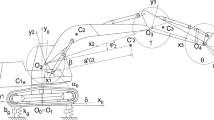Abstract
A structural model is significant for the verification of structural control algorithms. However, for nonlinear behavior, experiments are mostly destructive tests that are costly, and conducting repetitive structural experiments is difficult. Therefore, a repetitive structural vibration model is important for structural vibration control. In this study, a smart platform to realize different structural behaviors is developed based on the backstepping control algorithm. Lyapunov functions are used to derive the control law. Simulations show that the designed model can track the structural responses of different arbitrary linear structures very well. In addition, the proposed platform can track responses of different piecewise linear structures and desired models with various hysteresis very well. Numerical results verify the effectiveness of the proposed tracking controller through the backstepping method for the established platform.
Similar content being viewed by others
References
Chiu CH, Peng YF and Lin YW (2011), “Robust Intelligent Backstepping Tracking Control for Wheeled Inverted Pendulum,” Soft Computing, 15(10): 2029–2040.
Clough RW and Johnson SB (1966), “Effects of Stiffness Degradation on Earthquake Ductility Requirements,” Proceeding of 2nd Japan National Earthquake Engineering Conference, Tokyo, Japan, pp.227–232.
Elnashai AS and Izzuddin BA (1993), “Modeling of Material Nonlinearities in Steel Structures Subjected to Transient Dynamic Loading,” Earthquake Engineering & Structural Dynamics, 22(6): 509–532.
Fu J, Chai TY, Su CY and Jin Y (2013), “Motion/Force Tracking Control of Nonholonomic Mechanical Systems via Combining Cascaded Design and Backstepping,” Automatica, 49(12): 3682–3686.
Hu QL, Cao J and Zhang YZ (2009), “Robust Backstepping Sliding Mode Attitude Tracking and Vibration Damping of Flexible Spacecraft with Actuator Dynamics,” Journal of Aerospace Engineering, 22(2): 139–152.
Khalil HK (2001), Nonlinear Systems, Prentice-Hall, Inc., Englewood Cliffs. New Jersey.
Li LY, Cheng BW and Yu Y (2014), “Linear Structural Experimental Model Based on Model Reference Adaptive Control Method,” Proceedings of 6th World Conference of International Association for Structural Control and Monitoring, Barcelona, Spain.
Li LY, Song GB and Ou JP (2013), “A Nonlinear Structural Experiment Platform with Adjustable Plastic Hinges: Analysis and Vibration Control,” Smart Structures and Systems, 11(3): 315–329.
Reynolds WE and Christenson RE (2006), “Benchscale Nonlinear Test Structure for Structural Control Research,” Engineering Structures, 28(8): 1182–1189.
Soong TT (1998), “Experimental Simulation of Degrading Structures through Active Control,” Earthquake Engineering and Structural Dynamics, 27(2): 143–154.
Xian B, Guo JC and Zhang Y (2015), Adaptive Backstepping Tracking Control of a 6-DOF Unmanned Helicopter,” IEEE/CAA Journal of Automatica Sinica, 2(1): 19–24.
Yu JP, Chen B and Yu HS (2010), “Position Tracking Control of Induction Motors via Adaptive Fuzzy Backstepping,” Energy Conversion and Management, 51(11): 2345–2352.
Yu Y, Zhang Q, Wang JW and Sun CY (2014), “Robust Tracking Control for the Hypersonic Flight Vehicle via Backstepping Method,” Proceedings of the 33rd Chinese Control Conference, Nanjing, China, pp. 4306–4311.
Acknowledgments
This research was supported in part by the National Natural Science Foundation of China under Grant No. 51378093 and No. 91315301.
Author information
Authors and Affiliations
Corresponding author
Additional information
Supported by: National Natural Science Foundation of China under Grant No. 51378093 and No. 91315301
Rights and permissions
About this article
Cite this article
Li, L., Cheng, B., Zhang, Y. et al. Study of a smart platform based on backstepping control method. Earthq. Eng. Eng. Vib. 16, 599–608 (2017). https://doi.org/10.1007/s11803-017-0398-5
Received:
Accepted:
Published:
Issue Date:
DOI: https://doi.org/10.1007/s11803-017-0398-5




